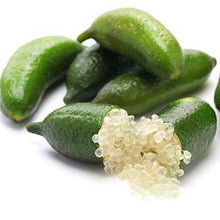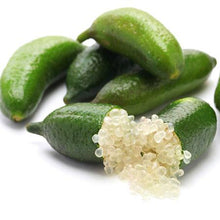Unique, Highly Productive Variety
Why Australian Finger Lime Trees?
This compact, bush-like tree works well in a variety of locations and produces delicious, one-of-a-kind fruit with flavorful crystals. The Australian Finger Lime Tree is also highly productive and grows vigorously in a wide range of climate conditions.
And you get this high level of production without hassle. A rare gourmet lime that hails from Australia, the Finger Lime is a unique citrus specimen that produces without effort. Its long, slender limes are unlike any you've ever seen. Slice one open and watch the pulp flow out from the rugged skin that protects it. Like small, spherical crystals, the tender vesicles inside are plump, juicy and filled with citrusy goodness.
The tough climate conditions of the Australian coastal regions where Finger Limes were first grown make it suitable for a diversity of planting locations with little care or maintenance. It will even tolerate cooler weather down to a brief frost. Plus, its compact, almost hedge-like stature makes it an excellent candidate for tight spots in the garden or throughout the landscape.
Why Fast-Growing-Trees.com is Better
The best part? We've planted, grown and nurtured our Australian Finger Lime Trees for success in your homescape. Because we've meticulously grown this unique citrus for months ahead of time, you get a well-rooted, healthier variety delivered directly to your door. You reap the rewards of our hard work - no effort on your part.
Whether it's Finger Lime ice cream, oysters with Finger Lime caviar, or even a Finger Lime gin fizz, if you're a citrus fan, the Finger Lime Tree will point you in the right direction. Order yours today!
Planting & Care
1. Planting: Choose a location where your tree is going to get plenty of sunlight (6 to 8 hours per day is best). They can tolerate some shade but thrive in full sun. Potted plants do enjoy a daily misting for humidity but placing a tray with rocks filled with water under the plant will feed humidity to the tree as the water evaporates.
If your winter temperatures drop consistently below 40 degrees, plant your tree in a container that can easily be brought outside in the summer months and inside in the winter. A planter with built-in casters is a good choice so it can easily be moved. Choose a pot slightly larger than what it was shipped in that has plenty of holes in the bottom to allow for drainage. Be sure to plant in well-draining potting soil, preferably recommended for acid-loving citrus plants.
Then, fill your pot with soil, place your tree, and backfill the rest of the soil. Finally, water to settle the roots.
2. Watering: After watering, generally about once or twice weekly, allow the top 2 to 3 inches of the soil to dry out completely before watering again. Mulching can help retain the soil moisture and also combat competing grasses/weeds.
When you water, stop once you see it escaping the drainage holes at the base of the pot.
3. Fertilizing: Feed your lime tree during the warmer spring and summer seasons with a citrus specific fertilizer once every six weeks, such as the one included in our Citrus Care Kit. During the fall and winter season, ease back to fertilizing once every 2 to 3 months. Once the tree has matured a bit and has got a few years on it, you can skip the cold season fertilization. Make sure to follow the application instructions written on the fertilizer bag.
4. Pruning: Make 45-degree angle cuts to remove dead or crossing limbs and also to thin out the tree to allow more light to flow between the branches. After the tree fruits, remove any dead wood and ventilate the center of the tree, and remove suckers as they grow from the base.
5. Pollination: Though this tree is self-fertile, for indoor trees, you can pollinate by hand since most people do not keep a healthy bee population within their home. Simply take a small, dry, fine-tipped paintbrush and stick it into the center of the bloom. Swirl it around and collect the pollen on the brush. Go to the next bloom and repeat the process until every bloom has been treated. Do this once daily and don’t wash the paintbrush until after the blooms have been pollinated. The bloom will fall off naturally and the fruit will begin to form in its place.



